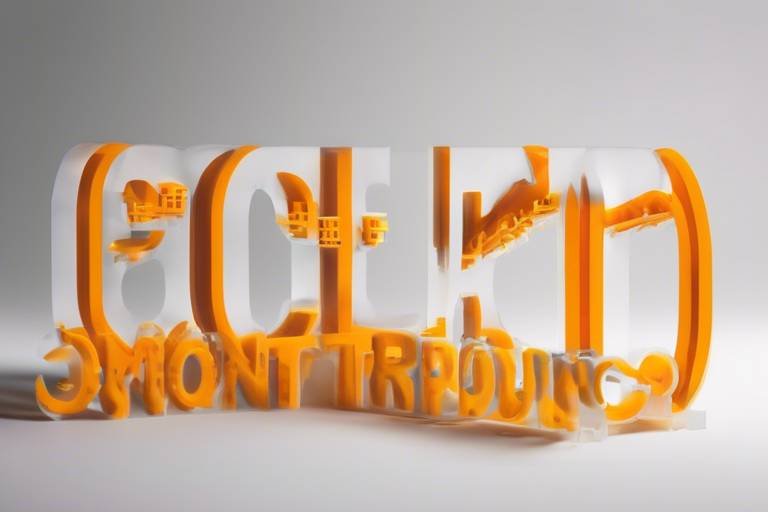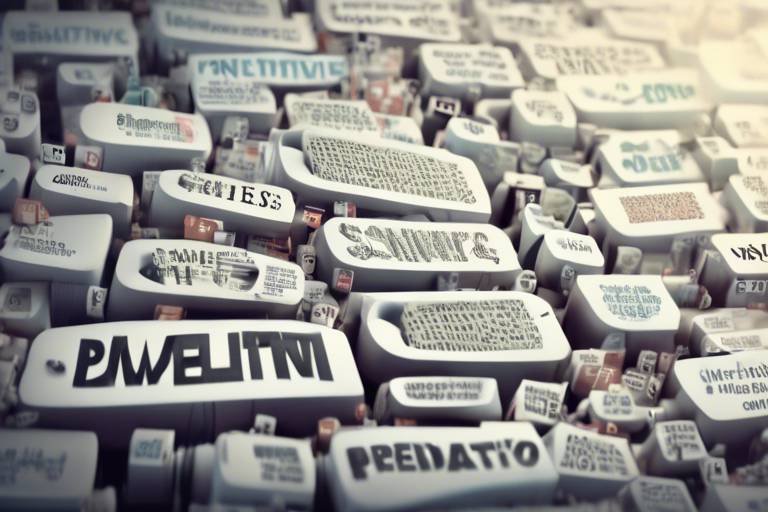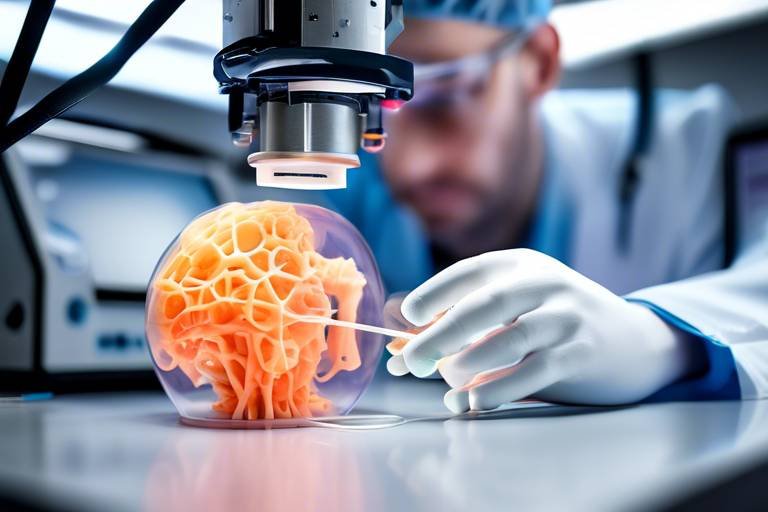3D Printing: A Manufacturing Revolution
Welcome to the future of manufacturing, where 3D printing is not just a trend but a transformative force reshaping the entire landscape of production. Imagine a world where products can be designed and created in a matter of hours, rather than weeks or months. This technology has taken the manufacturing industry by storm, offering unprecedented advantages that traditional methods simply cannot match. In this article, we'll explore how 3D printing is revolutionizing manufacturing, its vast applications, and the challenges it faces along the way.
So, what exactly is 3D printing? At its core, it's a process of creating three-dimensional objects from a digital file. This is achieved through various additive manufacturing techniques, which build up layers of material until the final product is formed. It's like sculpting, but instead of chipping away at a block of stone, you're adding material layer by layer. This innovative approach allows for the creation of complex geometries that were previously unimaginable.
One of the most exciting aspects of 3D printing is its ability to democratize manufacturing. Small businesses and startups can now compete with larger corporations by leveraging this technology to produce customized products tailored to individual customer needs. The barriers to entry have significantly lowered, making it easier than ever for entrepreneurs to bring their ideas to life. This shift is not only fostering innovation but also driving economic growth in various sectors.
However, the impact of 3D printing extends beyond just cost savings and accessibility. It also promotes sustainability in manufacturing. Traditional production methods often generate significant waste, but with 3D printing, material is only used where it's needed. This reduction in waste not only conserves resources but also minimizes the environmental footprint of manufacturing processes. Imagine a world where fewer raw materials are needed, and less energy is consumed—this is the promise of 3D printing.
As we delve deeper into the world of 3D printing, we will uncover its rich history, explore the different technologies involved, and examine the myriad benefits it brings to the manufacturing table. From cost efficiency to customization, the advantages are numerous, but so are the challenges. Regulatory hurdles, material limitations, and scalability issues are just a few of the obstacles that need to be addressed to fully realize the potential of this groundbreaking technology.
In the following sections, we will dissect the various types of 3D printing technologies, highlighting their unique characteristics and applications. We'll also take a closer look at the benefits and challenges that come with this manufacturing revolution. So, buckle up as we embark on this exciting journey through the world of 3D printing!
- What is 3D printing? - 3D printing is a manufacturing process that creates three-dimensional objects by adding material layer by layer from a digital file.
- What are the benefits of 3D printing? - Benefits include cost efficiency, design flexibility, reduced waste, and the ability to create customized products.
- What industries use 3D printing? - 3D printing is used in various industries, including healthcare, aerospace, automotive, and consumer products.
- What are the challenges of 3D printing? - Challenges include regulatory issues, material limitations, and scalability concerns.
- What is the future of 3D printing? - The future looks promising, with advancements in AI integration, automation, and sustainability practices expected to enhance the technology further.

The History of 3D Printing
Understanding the history of 3D printing is like peeling back the layers of an onion; each layer reveals a new and exciting development that has shaped the way we manufacture today. The journey began in the early 1980s when Chuck Hull, an American engineer, invented the first stereolithography (SLA) machine. This groundbreaking technology allowed for the creation of three-dimensional objects from digital files, marking a significant leap forward in manufacturing capabilities.
Fast forward to the 1990s, and the world saw the emergence of Fused Deposition Modeling (FDM), developed by Scott Crump. This method utilized thermoplastic materials to build objects layer by layer, making 3D printing more accessible and affordable for various industries. As the years progressed, 3D printing technologies diversified, leading to innovations like Selective Laser Sintering (SLS) and Digital Light Processing (DLP), each offering unique advantages and applications.
By the early 2000s, 3D printing began to capture the attention of not just manufacturers but also hobbyists and educators. The rise of open-source 3D printing platforms and affordable printers allowed individuals to experiment with this technology at home. This democratization of 3D printing sparked creativity and innovation, leading to the development of a vibrant community that shares designs and ideas.
Today, 3D printing is at the forefront of a manufacturing revolution, impacting industries ranging from healthcare to aerospace. The technology has evolved to incorporate a wide variety of materials, including metals, ceramics, and even biological materials, paving the way for applications that were once thought impossible. As we look to the future, the potential of 3D printing continues to expand, promising to reshape how we think about production, customization, and sustainability.
To summarize, the history of 3D printing is a tale of innovation and evolution. From its humble beginnings in the 1980s to its current status as a transformative force in manufacturing, 3D printing has proven to be a game-changer. As we continue to explore its capabilities, one can only imagine the possibilities that lie ahead.
- What is 3D printing? - 3D printing is a manufacturing process that creates three-dimensional objects from digital files by adding material layer by layer.
- What are the main types of 3D printing technologies? - The main types include Fused Deposition Modeling (FDM), Stereolithography (SLA), and Selective Laser Sintering (SLS).
- How is 3D printing used in healthcare? - 3D printing is used in healthcare for creating custom prosthetics, dental implants, and even bioprinting tissues and organs.
- What are the environmental benefits of 3D printing? - 3D printing can reduce waste by using only the necessary amount of material and can incorporate recyclable materials into the production process.

Types of 3D Printing Technologies
When diving into the world of 3D printing, it’s essential to understand that this innovative technology encompasses a variety of methods, each with its unique processes and materials. The diversity in 3D printing technologies allows manufacturers to choose the best option tailored to their specific needs, whether it's for rapid prototyping, producing intricate designs, or even creating end-use products. Let's explore some of the most common types of 3D printing technologies that are making waves in the industry today.
One of the most popular methods is Fused Deposition Modeling (FDM). This technique works by extruding thermoplastic filaments through a heated nozzle, which deposits the material layer by layer to create a 3D object. FDM is widely appreciated for its accessibility and cost-effectiveness, making it a go-to choice for educational institutions and hobbyists. However, it’s crucial to note that while FDM is versatile, it does have its limitations, particularly in terms of material variety and surface finish quality.
Another prominent method is Stereolithography (SLA). SLA utilizes a laser to cure liquid resin into a solid form, allowing for incredibly precise and detailed prints. This technology is particularly favored in industries that require high accuracy, such as jewelry design and medical applications. The level of detail achievable with SLA is often unmatched, but it typically comes with higher costs and longer production times compared to FDM.
In addition to these, there are other notable technologies worth mentioning:
- Selective Laser Sintering (SLS): This method fuses powdered materials using a laser, creating robust and functional parts suitable for end-use applications.
- Digital Light Processing (DLP): Similar to SLA, DLP uses a digital light projector to cure resin, but it does so layer by layer, allowing for faster print times.
- Binder Jetting: This technique involves depositing a liquid binding agent onto layers of powder, which can then be sintered or cured to create solid objects.
Each of these technologies has its own set of advantages and challenges, making it vital for businesses to assess their specific requirements before choosing a method. For instance, while FDM may be perfect for prototyping, SLS might be better suited for producing functional parts that require durability. Understanding these differences can help manufacturers optimize their production processes and achieve better results.
As the 3D printing landscape continues to evolve, new technologies and improvements to existing methods are constantly emerging. This innovation not only enhances the capabilities of 3D printing but also opens up new possibilities for industries ranging from aerospace to healthcare. The future of manufacturing is indeed bright, and 3D printing technologies are at the forefront of this revolution.
Q: What is the most common type of 3D printing technology?
A: Fused Deposition Modeling (FDM) is the most commonly used 3D printing technology due to its accessibility and cost-effectiveness.
Q: How does Stereolithography (SLA) differ from FDM?
A: SLA uses a laser to cure liquid resin into solid forms, allowing for higher precision and detail compared to FDM, which extrudes thermoplastic filaments.
Q: What industries benefit the most from 3D printing technologies?
A: Industries such as healthcare, aerospace, automotive, and consumer products benefit significantly from 3D printing technologies due to their ability to create customized and complex designs.

Fused Deposition Modeling (FDM)
Fused Deposition Modeling, commonly known as FDM, is one of the most widely adopted 3D printing technologies in the world. It operates on a simple yet effective principle: a thermoplastic filament is heated and extruded through a nozzle, layer by layer, to create a three-dimensional object. This technique was first developed in the 1980s by Scott Crump, and since then, it has evolved into a cornerstone of modern manufacturing. FDM is particularly favored for its ease of use and accessibility, making it a go-to choice for enthusiasts, educators, and professionals alike.
At the heart of FDM technology is its ability to create complex geometries with relative simplicity. The process begins with a digital model, often designed using CAD software. Once the model is ready, the FDM printer slices it into thin layers, translating the design into a format that the printer can understand. The heated nozzle then deposits the molten filament onto a build platform, gradually constructing the object layer by layer. This method allows for intricate designs that would be challenging, if not impossible, to achieve with traditional manufacturing methods.
One of the standout features of FDM is its versatility in terms of materials. A variety of thermoplastics can be used, including ABS (Acrylonitrile Butadiene Styrene), PLA (Polylactic Acid), and PETG (Polyethylene Terephthalate Glycol), each offering different properties and applications. For instance, while PLA is renowned for its ease of use and eco-friendliness, ABS is favored for its strength and durability. This range of options provides manufacturers with the flexibility to choose materials that best suit their specific needs.
However, like any technology, FDM has its limitations. One of the most significant challenges is the surface finish quality. Objects produced using FDM can exhibit visible layer lines, which may not be ideal for products requiring a smooth finish. Additionally, the mechanical properties of FDM-printed parts can vary depending on the orientation of the print, leading to potential weaknesses in certain areas. To address these issues, ongoing research and development are focused on improving the technology, including advancements in nozzle designs and the introduction of new materials.
In conclusion, FDM stands as a powerful tool in the realm of 3D printing, offering a unique blend of accessibility, versatility, and innovation. Its application spans across various industries, from prototyping and education to consumer products and beyond. As technology continues to advance, FDM is likely to evolve, providing even more opportunities for creative solutions in manufacturing.
FDM technology is utilized in various fields, including:
- Prototyping: Rapidly creating models for testing and validation.
- Education: Providing hands-on learning experiences in schools and universities.
- Consumer Products: Manufacturing customized items tailored to individual preferences.
Despite its popularity, FDM has limitations such as:
- Material Restrictions: Limited range of materials compared to other printing methods.
- Surface Finish Quality: Visible layer lines can affect aesthetics.

Applications of FDM
Fused Deposition Modeling (FDM) has carved out a significant niche in various industries due to its versatility and ease of use. One of the most compelling aspects of FDM is its ability to produce functional prototypes quickly, which is invaluable in fields like product design and engineering. Imagine a designer sketching a concept and being able to hold a tangible model in their hands within hours! This rapid prototyping capability allows for iterative testing and refinement, reducing time-to-market for new products.
Moreover, FDM is widely used in education. Schools and universities are leveraging this technology to teach students about engineering principles, design thinking, and manufacturing processes. By engaging in hands-on projects, students can better grasp complex concepts and develop critical problem-solving skills. For instance, a student might design a custom tool or a unique art piece, bringing their ideas to life through 3D printing.
In the realm of consumer products, FDM has made a mark by enabling the creation of personalized items. Think about customized phone cases or unique jewelry designs tailored to individual preferences. This level of personalization not only enhances customer satisfaction but also fosters brand loyalty. Companies can now offer products that resonate with their customers on a personal level, which is a game-changer in today’s competitive market.
Additionally, FDM finds applications in the medical field. From creating custom prosthetics to developing surgical models, the technology is revolutionizing patient care. For example, surgeons can use 3D-printed models of a patient’s anatomy to plan complex surgeries, significantly improving outcomes. This capability not only enhances precision but also reduces recovery times, making it a win-win for both patients and healthcare providers.
To illustrate the diverse applications of FDM, here's a table summarizing some key sectors and specific uses:
| Industry | Applications |
|---|---|
| Product Design | Rapid prototyping, functional testing |
| Education | Hands-on learning, project-based assignments |
| Consumer Goods | Custom products, personalized gifts |
| Healthcare | Custom prosthetics, surgical models |
In summary, the applications of FDM are as diverse as they are impactful. From transforming the way products are designed to enhancing educational experiences and improving healthcare outcomes, FDM is paving the way for innovation across multiple sectors. As technology continues to advance, we can only anticipate even more exciting applications in the near future.
- What materials can be used in FDM printing? FDM typically uses thermoplastics like PLA, ABS, and PETG, each offering unique properties suited for different applications.
- Is FDM suitable for large-scale production? While FDM is excellent for prototyping and small-batch production, it may not be as cost-effective for large-scale manufacturing compared to traditional methods.
- How does FDM compare to other 3D printing technologies? FDM is generally more accessible and cost-effective than technologies like SLA or SLS but may not offer the same level of precision or material variety.

Limitations of FDM
While Fused Deposition Modeling (FDM) has revolutionized the way we think about manufacturing and prototyping, it is not without its limitations. One of the most significant challenges faced by FDM technology is the material restriction. The types of materials suitable for FDM are primarily thermoplastics, which may not always provide the required strength or durability for certain applications. This limitation can hinder its use in industries where high-performance materials are essential, such as aerospace or automotive sectors.
Another critical aspect to consider is the surface finish quality. FDM prints often exhibit visible layer lines, which can affect the aesthetic appeal of the final product. While post-processing techniques like sanding or painting can improve the finish, they can also add time and cost to the production process. This might not be a deal-breaker for prototypes or models, but for end-use parts, it can be a significant drawback.
Moreover, FDM printers can struggle with complex geometries. Although they can produce intricate designs, certain shapes may require support structures that complicate the printing process. These supports can leave marks or require additional post-processing, which can be frustrating for users looking for a seamless experience.
Another limitation is the printing speed. While FDM technology is generally faster than some other 3D printing methods, the speed can vary significantly based on the complexity of the model and the settings used. High-quality prints may take a considerable amount of time, which can be a constraint for businesses needing rapid prototyping.
Lastly, there are environmental factors to consider. FDM printers can be sensitive to temperature and humidity, which can affect print quality. For instance, if the ambient temperature is too low, the filament may not adhere properly, leading to failed prints. This sensitivity can complicate the operation of FDM printers in less controlled environments.
In summary, while FDM technology offers numerous advantages, understanding its limitations is crucial for users looking to maximize its potential. By being aware of these challenges, manufacturers and hobbyists alike can take steps to mitigate them, ensuring a smoother and more efficient printing process.
- What materials can be used with FDM printers? FDM printers primarily use thermoplastic materials such as PLA, ABS, PETG, and TPU.
- How can I improve the surface finish of FDM prints? Techniques such as sanding, painting, or applying a smoothing solution can enhance the surface finish.
- Can FDM printers handle complex geometries? Yes, but they may require support structures that can complicate the printing process.
- What factors affect the printing speed of FDM? The complexity of the model, layer height, and printer settings can all influence printing speed.
- Are FDM printers sensitive to environmental conditions? Yes, factors like temperature and humidity can significantly impact print quality.

Stereolithography (SLA)
Stereolithography, commonly known as SLA, is a revolutionary 3D printing technology that has made a significant impact on various industries. Developed in the 1980s by Chuck Hull, SLA utilizes a process called photopolymerization, where liquid resin is cured into hardened plastic using an ultraviolet (UV) laser. This method allows for the creation of highly detailed and precise objects, making it a popular choice for industries that require intricate designs.
One of the standout features of SLA is its ability to produce parts with exceptional surface finish and accuracy. Because the laser can be finely controlled, SLA printers can achieve layer resolutions as thin as 25 microns. This level of precision is particularly beneficial in sectors such as medical device manufacturing, where even the smallest imperfections can lead to significant issues. For instance, dental models and surgical guides produced through SLA are not only accurate but also help in enhancing patient outcomes.
Moreover, the materials used in SLA printing are diverse, ranging from rigid resins to flexible options, allowing for a wide array of applications. This versatility makes SLA an attractive option for prototyping, as designers can quickly iterate their designs and produce functional prototypes that closely mimic the final product. Companies can save time and reduce costs by using SLA for rapid prototyping, thus streamlining their product development processes.
However, while SLA boasts many advantages, it is not without its challenges. The post-processing stage can be labor-intensive, as printed parts typically require cleaning and curing to achieve the desired mechanical properties. Additionally, the materials used in SLA can be more expensive compared to those used in other 3D printing methods like FDM. This can be a consideration for businesses looking to balance cost with quality.
In summary, Stereolithography stands out as a powerful 3D printing technology that combines precision and versatility. Its ability to produce high-quality parts makes it an invaluable tool in industries ranging from aerospace to healthcare. As technology continues to advance, we can expect to see even more innovative applications of SLA, further solidifying its place in the manufacturing landscape.
- What is the primary advantage of SLA over other 3D printing technologies?
SLA offers superior precision and surface finish, making it ideal for detailed applications. - Can SLA be used for mass production?
While SLA is excellent for prototyping and small batch production, it is generally not as efficient for large-scale manufacturing compared to other methods. - What types of materials can be used in SLA printing?
SLA typically uses photopolymer resins, which can vary in properties from rigid to flexible, catering to diverse application needs. - Is post-processing necessary for SLA printed parts?
Yes, post-processing is essential to ensure the parts achieve the desired strength and finish.

Benefits of 3D Printing in Manufacturing
3D printing is not just a passing trend; it’s a game changer in the world of manufacturing. Imagine a factory where products can be created from a digital file, eliminating the need for complex tooling and machinery. This revolutionary technology brings a plethora of benefits that are reshaping the way we think about production. One of the most significant advantages is cost savings. Traditional manufacturing processes often lead to substantial material waste, but with 3D printing, materials are used more efficiently. For instance, by building objects layer by layer, manufacturers can minimize excess and reduce overall costs.
Additionally, 3D printing offers remarkable design flexibility. Unlike traditional methods that may restrict creativity due to tooling constraints, 3D printing allows designers to explore intricate and complex geometries that were previously impossible to achieve. This level of customization not only enhances product development but also significantly boosts consumer satisfaction. Think about it: consumers today crave personalized products, and 3D printing makes that a reality. Whether it’s custom-fit shoes or unique jewelry designs, the possibilities are endless.
Another major benefit is the potential for reduced lead times. In traditional manufacturing, producing a new product often involves lengthy processes, from design to prototyping to production. However, with 3D printing, prototypes can be created rapidly, allowing for quicker iterations and faster time-to-market. This agility is crucial in today’s fast-paced market, where being first can mean the difference between success and failure.
Moreover, 3D printing can significantly contribute to sustainability. As the world becomes more environmentally conscious, manufacturers are searching for ways to reduce their carbon footprint. 3D printing can help in this regard by using only the necessary amount of material and enabling the recycling of unused filament. Companies can also explore the use of eco-friendly materials, further promoting sustainability. In fact, many organizations are actively researching biodegradable materials that can be used in 3D printing, paving the way for a greener future.
However, it’s essential to recognize that while the benefits are substantial, the adoption of 3D printing in manufacturing is not without its challenges. Companies must navigate through regulatory hurdles, material limitations, and the need for skilled personnel to operate advanced 3D printers. But with ongoing advancements in technology and a growing understanding of the process, the benefits of 3D printing are becoming increasingly clear.
In summary, 3D printing is revolutionizing manufacturing by offering cost efficiency, design freedom, reduced lead times, and sustainability. As industries continue to embrace this technology, we can expect to see even more innovative applications and products that challenge our conventional notions of manufacturing.
- What is 3D printing? 3D printing is a manufacturing process that creates three-dimensional objects from a digital file by adding material layer by layer.
- What are the main benefits of 3D printing? Key benefits include cost savings, design flexibility, reduced lead times, and sustainability.
- What industries are using 3D printing? Industries such as healthcare, aerospace, automotive, and consumer products are leveraging 3D printing for various applications.
- Are there any limitations to 3D printing? Yes, challenges include material restrictions, regulatory issues, and the need for skilled operators.
- How is 3D printing contributing to sustainability? 3D printing reduces material waste and can utilize eco-friendly materials, promoting more sustainable manufacturing practices.

Cost Efficiency
One of the most compelling aspects of 3D printing is its remarkable ability to drive in manufacturing processes. Imagine a world where businesses can produce complex parts without the hefty price tag associated with traditional manufacturing methods. By minimizing material waste and reducing labor costs, 3D printing can significantly lower production expenses. This is not just a theoretical benefit; it’s a reality that many companies are embracing today.
To understand how 3D printing achieves these savings, consider the following key factors:
- Material Waste Reduction: Traditional manufacturing often involves cutting away material from a larger block, which can lead to substantial waste. In contrast, 3D printing builds objects layer by layer, using only the material necessary for the final product. This not only conserves resources but also reduces costs associated with waste disposal.
- Lower Labor Costs: The automation of 3D printing processes means that fewer workers are needed for production. While skilled technicians are still essential, the overall labor requirement is significantly reduced, leading to lower operational costs.
- Rapid Prototyping: The ability to quickly produce prototypes allows companies to test designs and iterate rapidly without incurring high costs. This accelerates the product development cycle and enables businesses to bring products to market faster, enhancing their competitive edge.
Let’s break down the financial implications of these factors. A recent study showed that companies adopting 3D printing technologies could reduce their manufacturing costs by as much as 30% to 50% in some cases. Not only does this provide immediate savings, but it also opens the door for companies to invest in research and development, further enhancing their product offerings.
Moreover, the flexibility of 3D printing allows for on-demand production, which means companies can produce items as needed rather than maintaining large inventories. This just-in-time model minimizes storage costs and reduces the risk of overproduction, which can lead to unsold inventory and wasted resources.
In summary, the cost efficiency offered by 3D printing is a game changer for manufacturers. It allows businesses to operate more sustainably and profitably, paving the way for innovation and growth in an increasingly competitive market. As more industries recognize these benefits, we can expect a significant shift in how products are designed and manufactured in the future.
- What is the primary advantage of 3D printing in terms of cost?
3D printing significantly reduces material waste and labor costs, leading to overall lower production expenses. - How does 3D printing affect prototyping costs?
3D printing allows for rapid prototyping, which reduces the costs associated with testing and developing new products. - Can 3D printing help with inventory costs?
Yes, 3D printing supports on-demand production, which minimizes the need for large inventories and reduces storage costs.

Customization and Design Freedom
One of the most exciting aspects of 3D printing is the unparalleled level of customization it offers. In traditional manufacturing, creating unique products often involves lengthy and expensive processes, but with 3D printing, the rules of the game change dramatically. Imagine being able to design a product that perfectly meets your needs, whether it's a specialized tool, a unique piece of jewelry, or even custom-fit prosthetics. This level of personalization not only enhances user satisfaction but also opens up a world of possibilities for manufacturers.
With 3D printing, the design freedom is virtually limitless. Designers can create intricate geometries and complex structures that would be impossible to achieve using conventional methods. This means that companies can produce items that are not only functional but also aesthetically pleasing. For instance, in the fashion industry, designers can experiment with shapes and patterns that push the boundaries of traditional garment construction. The ability to prototype quickly allows for rapid iterations, meaning ideas can be tested and refined without the hefty costs associated with traditional manufacturing.
Moreover, the customization potential extends beyond individual products. Businesses can leverage 3D printing to create small batches of tailored items, catering to niche markets or specific customer demands. This flexibility is particularly beneficial in sectors such as healthcare, where devices can be designed to fit the unique anatomy of a patient, enhancing comfort and effectiveness. In automotive and aerospace industries, manufacturers can produce lightweight components that are custom-engineered for specific performance criteria, improving overall efficiency.
However, with great customization comes the need for effective design software and skilled personnel. The learning curve associated with advanced design tools can be steep, but the investment in training pays off when you consider the potential for innovation. As more businesses adopt 3D printing, we are likely to see an increase in user-friendly software solutions that simplify the design process, making it accessible to a broader range of users.
In summary, the customization and design freedom offered by 3D printing is revolutionizing how products are conceived, designed, and manufactured. It fosters creativity, encourages innovation, and ultimately leads to a more personalized experience for consumers. As technology continues to evolve, the possibilities for customization will only expand, making it an exciting time for both manufacturers and consumers alike.
- What are the benefits of customizing products with 3D printing?
Customization allows for tailored solutions that meet specific customer needs, enhances user satisfaction, and can lead to innovative product designs. - Can small businesses afford 3D printing technology?
Yes, many 3D printers are now affordable for small businesses, and the cost savings from reduced material waste and labor can offset the initial investment. - What industries benefit most from 3D printing customization?
Industries such as healthcare, fashion, automotive, and aerospace are among those that significantly benefit from the customization capabilities of 3D printing.

Challenges Facing 3D Printing
While the world of 3D printing is exciting and full of potential, it doesn't come without its fair share of challenges. As with any emerging technology, navigating the complexities of 3D printing can feel a bit like trying to find your way through a maze—one misstep, and you could hit a wall. From regulatory hurdles to material limitations, the obstacles are real and require innovative solutions to overcome.
One of the most significant challenges is the regulatory and compliance issues that come into play, especially in sensitive industries like healthcare and aerospace. These sectors demand high standards of safety and reliability, and as such, they are governed by strict regulations. Navigating this landscape can be daunting for manufacturers looking to adopt 3D printing technologies. For instance, the FDA has specific guidelines for medical devices produced through 3D printing, which can complicate the approval process. It's essential for companies to stay informed about these regulations to avoid costly delays.
Another pressing concern is the material limitations associated with 3D printing. While the technology has advanced significantly, the range of materials available for printing is still relatively narrow compared to traditional manufacturing methods. This limitation can restrict the types of products that can be created and can impact the performance of those products. For example, while plastics are widely used, they may not always provide the strength or durability required for certain applications. Ongoing research and development are crucial to expanding the material options available for 3D printing, and many companies are investing heavily in this area.
In addition to these challenges, there’s also the issue of scalability. While 3D printing is fantastic for prototyping and low-volume production, scaling up to meet high demand can present difficulties. Traditional manufacturing processes are often more efficient for mass production, and companies must carefully consider when to use 3D printing versus traditional methods. This balancing act can be tricky, especially as businesses strive to meet consumer demand without sacrificing quality.
To summarize, the challenges facing 3D printing are multifaceted and require a strategic approach to address them effectively. Companies must be proactive in understanding the regulatory landscape, investing in material research, and developing scalable solutions. The road ahead may be bumpy, but with determination and innovation, the potential rewards of 3D printing can far outweigh the challenges.
- What are the main challenges of 3D printing? The primary challenges include regulatory issues, material limitations, and scalability concerns.
- How does regulation impact 3D printing? Regulations can complicate the adoption of 3D printing in industries like healthcare and aerospace, requiring compliance with strict safety standards.
- What materials are commonly used in 3D printing? Common materials include various plastics, metals, and ceramics, but the range is still limited compared to traditional manufacturing.
- Can 3D printing be scaled for mass production? While 3D printing excels in prototyping and low-volume production, scaling up for mass production can be challenging and often requires a hybrid approach with traditional methods.

Regulatory and Compliance Issues
As the world of 3D printing continues to expand, navigating the intricate web of becomes increasingly crucial, especially in sensitive sectors like healthcare and aerospace. These industries are heavily regulated due to the potential risks associated with product failures, which can have dire consequences. For instance, in healthcare, the production of medical devices using 3D printing must comply with strict guidelines set forth by authorities such as the Food and Drug Administration (FDA) in the United States. This ensures that any device manufactured is safe and effective for patient use.
Moreover, the complexity of regulations can vary significantly from one region to another. In Europe, the Medical Device Regulation (MDR) outlines stringent requirements for 3D printed medical devices, mandating rigorous testing and documentation. This can create a challenging landscape for manufacturers who wish to market their products internationally. Understanding and adhering to these regulations is not just a matter of compliance; it is essential for building trust with consumers and stakeholders.
To address these challenges, many companies are investing in compliance specialists who can help navigate the regulatory landscape. Additionally, some organizations are advocating for clearer guidelines that specifically address the nuances of 3D printing technology. A collaborative approach between manufacturers, regulators, and industry experts is vital to create a framework that fosters innovation while ensuring safety and efficacy.
In summary, while the potential of 3D printing is vast, its growth is tempered by the need for robust regulatory frameworks. As the technology evolves, so too must the regulations that govern its use. This ongoing dialogue between innovation and regulation will ultimately shape the future of 3D printing in various industries.
- What are the main regulatory bodies for 3D printing? The main regulatory bodies include the FDA in the U.S. and the European Medicines Agency (EMA) in Europe, among others.
- How can companies ensure compliance with regulations? Companies can ensure compliance by staying informed about regulations, conducting thorough testing, and consulting with compliance experts.
- Are there any specific regulations for 3D printed medical devices? Yes, 3D printed medical devices must comply with specific regulations such as the FDA's guidelines and the EU's MDR.

Material Limitations
When we think about the incredible possibilities of 3D printing, it's easy to get lost in the excitement of its applications and innovations. However, one of the significant hurdles that still looms over this technology is the limitations of materials used in the printing process. While there is a growing variety of materials available for 3D printing, each comes with its own set of challenges that can restrict their use in various industries.
One of the main issues is that many 3D printing materials, particularly plastics, have certain mechanical properties that may not meet the rigorous demands of specific applications. For example, while materials like PLA (Polylactic Acid) and ABS (Acrylonitrile Butadiene Styrene) are popular for prototyping and consumer products, they may not withstand high temperatures or heavy loads, making them unsuitable for aerospace or automotive applications. This limitation can lead to significant constraints in product design and functionality.
Moreover, the range of materials currently available for 3D printing is still relatively narrow compared to traditional manufacturing methods. This can be particularly problematic in industries that require specialized materials, such as metals or ceramics. While advancements are being made, the ability to print with high-performance materials is still in its infancy. For instance, though metal 3D printing technologies like Selective Laser Melting (SLM) are emerging, they often come with high costs and technical complexities that can be prohibitive for many manufacturers.
Another challenge is the surface finish and resolution of printed parts. Many 3D printed items exhibit a rough texture or visible layer lines, which can detract from their aesthetic appeal and functional performance. This is particularly critical in industries like healthcare, where implants and prosthetics must not only function well but also look appealing and be biocompatible.
To address these limitations, ongoing research and development are crucial. Innovations in material science are paving the way for the creation of new composites and blends that can enhance the properties of traditional materials. For example, researchers are exploring the use of bio-based plastics, which could provide a more sustainable option without compromising on performance. Additionally, advancements in multi-material printing allow for the combination of different materials in a single print, potentially overcoming some of the limitations associated with individual materials.
In summary, while the potential of 3D printing is vast, the limitations of materials pose a significant challenge that the industry must overcome. By continuously pushing the boundaries of material science and technology, we can unlock even greater possibilities for 3D printing, making it a truly revolutionary force in manufacturing.
- What are the most common materials used in 3D printing? The most common materials include various plastics such as PLA and ABS, as well as metals like titanium and aluminum.
- Can 3D printing materials be recycled? Yes, many 3D printing materials, especially plastics like PLA, can be recycled, promoting sustainability.
- Are there any materials that are not suitable for 3D printing? Yes, materials that require specific manufacturing processes, such as certain ceramics or composites, may not be suitable for current 3D printing technologies.

The Future of 3D Printing
The future of 3D printing is nothing short of exhilarating! As we stand on the brink of a new manufacturing era, the possibilities seem endless. With advancements in technology, we can expect to see innovative applications and improvements that will revolutionize how we design and produce everything from simple toys to complex aerospace components. Imagine a world where you can print your own customized products right at home or where manufacturers can create intricate parts on-demand, reducing inventory costs and waste. Sounds like science fiction, right? But it’s quickly becoming a reality!
One of the most exciting trends is the integration of artificial intelligence (AI) and automation into the 3D printing process. By harnessing AI, manufacturers can optimize designs, predict failures, and streamline production processes. This means not only faster production times but also enhanced precision. For instance, AI algorithms can analyze vast amounts of data to determine the best materials and techniques for specific applications, leading to improved product quality and reduced errors.
Moreover, the push towards sustainability is gaining momentum. As environmental concerns grow, 3D printing offers a unique solution by minimizing waste and utilizing recyclable materials. Imagine a future where factories operate with a zero-waste philosophy, creating products from biodegradable plastics or even recycled waste. This shift not only benefits the planet but also appeals to increasingly eco-conscious consumers who prioritize sustainability in their purchasing decisions.
To illustrate the potential of 3D printing in fostering sustainability, consider the following table that outlines some key innovations:
| Innovation | Description | Impact |
|---|---|---|
| Bioprinting | Creating living tissues and organs for medical applications. | Revolutionizes transplant medicine and reduces the need for organ donors. |
| Recyclable Materials | Developing filaments made from recycled plastics. | Reduces plastic waste and promotes a circular economy. |
| Energy-Efficient Processes | Utilizing less energy in production compared to traditional methods. | Decreases carbon footprint and operational costs. |
As we look to the future, it’s also crucial to address the challenges that lie ahead. The regulatory landscape must evolve to keep pace with these innovations. Industries such as healthcare and aerospace require stringent compliance measures to ensure safety and reliability. The challenge is to create regulations that protect consumers without stifling innovation. Collaboration between industry leaders and regulatory bodies will be vital in developing frameworks that support growth while ensuring safety.
In conclusion, the future of 3D printing is bright and full of potential. With advancements in AI, a focus on sustainability, and the ongoing evolution of regulations, we are poised for a manufacturing revolution that could change the way we live and work. Are you ready to embrace this exciting future? The possibilities are limited only by our imagination!
- What industries will benefit the most from 3D printing? Industries such as healthcare, aerospace, automotive, and consumer goods are expected to see significant benefits from adopting 3D printing technologies.
- Is 3D printing environmentally friendly? Yes, 3D printing can be environmentally friendly by reducing waste and using recyclable materials, promoting a more sustainable manufacturing process.
- What are the main challenges facing 3D printing? Key challenges include regulatory compliance, material limitations, and scalability in production.
- How will AI impact 3D printing? AI will enhance design optimization, predict failures, and streamline production processes, leading to greater efficiency and precision.

Integrating AI and Automation
The integration of artificial intelligence (AI) and automation into the world of 3D printing is nothing short of revolutionary. Imagine a factory where machines not only produce parts but also learn from their mistakes, optimize processes, and adapt to new designs on the fly. This is not science fiction; it's the future of manufacturing. By leveraging AI, manufacturers can enhance the efficiency and precision of their production lines, leading to faster turnaround times and reduced costs.
One of the most exciting aspects of integrating AI with 3D printing is the ability to predict failures before they happen. AI algorithms can analyze vast amounts of data from previous prints to identify patterns and anomalies. For instance, if a certain temperature setting consistently leads to defects, the AI can suggest adjustments in real-time. This predictive capability not only saves time but also minimizes waste, making the entire process more sustainable.
Moreover, automation in 3D printing isn't just about speeding up production; it's also about enhancing quality control. Automated systems can monitor each layer of a print, ensuring that every detail is as intended. If something goes awry, the system can halt production immediately, preventing a cascade of errors that could result in significant material loss. This level of oversight is invaluable, especially in industries where precision is paramount, such as aerospace and healthcare.
As we look to the future, the combination of AI and automation will likely lead to the development of smart factories. These factories will be interconnected, sharing data across machines and systems to optimize the entire manufacturing process. The potential benefits are enormous:
- Increased Production Speed: Automated systems can operate 24/7 without fatigue.
- Enhanced Customization: AI can quickly adapt designs based on consumer feedback and preferences.
- Improved Resource Management: AI can analyze supply chain data to reduce costs and improve efficiency.
In conclusion, the integration of AI and automation in 3D printing is not just a trend; it's a paradigm shift that could redefine how products are designed and manufactured. As technology continues to advance, we can expect to see even more innovative applications that will push the boundaries of what's possible in the manufacturing landscape.
Q1: How does AI improve the 3D printing process?
A1: AI enhances the 3D printing process by analyzing data to predict failures, optimize settings, and ensure quality control throughout production.
Q2: What are the benefits of automation in 3D printing?
A2: Automation increases production speed, reduces labor costs, and enhances quality control, leading to more efficient and reliable manufacturing processes.
Q3: Can AI help in customizing products?
A3: Yes, AI can quickly adapt designs based on consumer preferences and feedback, allowing for greater customization in product development.
Q4: What industries can benefit from AI and automation in 3D printing?
A4: Industries such as aerospace, healthcare, automotive, and consumer goods can greatly benefit from these technologies due to their need for precision and efficiency.

Sustainability and Eco-Friendly Practices
In today's world, where environmental concerns are at the forefront of global discussions, sustainability has become a vital aspect of manufacturing practices. 3D printing, often hailed as a revolutionary technology, has the potential to significantly contribute to eco-friendly initiatives. By minimizing waste and allowing for the creation of products using less material, 3D printing aligns perfectly with the principles of sustainable manufacturing. Traditional manufacturing methods often involve cutting away large portions of material, resulting in substantial waste. In contrast, 3D printing employs an additive process, where materials are added layer by layer, effectively reducing excess waste. This not only conserves resources but also decreases the environmental footprint of production.
Moreover, 3D printing enables manufacturers to utilize recyclable materials and bio-based plastics, further enhancing sustainability efforts. As research progresses, the development of new materials that are both high-performing and eco-friendly is becoming more prevalent. For instance, companies are now experimenting with materials derived from natural sources, such as algae or corn starch, which can decompose more easily than traditional plastics. This innovation opens up exciting possibilities for creating products that are not only functional but also environmentally responsible.
Another significant advantage of 3D printing in terms of sustainability is its ability to facilitate localized production. Rather than relying on extensive supply chains that contribute to carbon emissions through transportation, 3D printing allows for on-demand manufacturing closer to the end user. This means that products can be produced as needed, reducing the need for large inventories and minimizing the energy consumed in transporting goods over long distances. As a result, businesses can operate more efficiently while also being kinder to the planet.
However, it’s essential to acknowledge that the journey toward sustainability in 3D printing is not without its challenges. The industry must address issues such as the energy consumption of 3D printers and the environmental impact of certain materials used in the printing process. As technology evolves, there is a growing emphasis on improving the energy efficiency of printers and developing materials that are both high-quality and sustainable. The future holds promise for innovations that will further enhance the eco-friendliness of 3D printing processes, making them a cornerstone of sustainable manufacturing practices.
In summary, the integration of sustainability and eco-friendly practices into 3D printing is not just a trend but a necessary evolution in manufacturing. By reducing waste, utilizing recyclable materials, and promoting localized production, 3D printing is poised to play a crucial role in shaping a greener future. As we continue to innovate and adapt, the potential for 3D printing to contribute positively to environmental sustainability will only grow stronger.
- What are the main environmental benefits of 3D printing?
3D printing reduces material waste, allows for the use of recyclable materials, and enables localized production, all of which contribute to a smaller environmental footprint.
- Can 3D printing use eco-friendly materials?
Yes, there are many eco-friendly materials available for 3D printing, including biodegradable plastics and materials derived from natural sources.
- How does 3D printing promote localized production?
3D printing allows products to be manufactured on-demand and closer to the consumer, reducing the need for long-distance transportation and large inventories.
- What challenges does 3D printing face in terms of sustainability?
Challenges include the energy consumption of 3D printers and the environmental impact of certain materials, but ongoing research aims to address these issues.
Frequently Asked Questions
- What is 3D printing?
3D printing, also known as additive manufacturing, is a process that creates three-dimensional objects by layering materials based on digital models. It has revolutionized manufacturing by allowing for rapid prototyping and complex designs that traditional methods can't achieve.
- How does Fused Deposition Modeling (FDM) work?
FDM works by melting thermoplastic filaments and extruding them through a heated nozzle. The printer lays down the material layer by layer, gradually building up the object. This method is popular for its ease of use and cost-effectiveness.
- What are the main applications of 3D printing?
3D printing is used in various sectors, including healthcare for custom prosthetics, aerospace for lightweight components, and education for hands-on learning tools. Its versatility makes it applicable across numerous industries, enhancing innovation and efficiency.
- What are the benefits of 3D printing in manufacturing?
The benefits include cost savings through reduced material waste, increased design flexibility allowing for customization, and faster production times. These advantages help businesses remain competitive in a rapidly changing market.
- What challenges does 3D printing face?
Challenges include regulatory compliance, especially in sensitive fields like healthcare, material limitations that restrict the types of products that can be made, and scalability issues for mass production. Addressing these hurdles is essential for broader adoption.
- How is 3D printing expected to evolve in the future?
The future of 3D printing looks promising with advancements in AI and automation, enhancing efficiency. Additionally, a focus on sustainability, such as using recyclable materials and reducing waste, will likely shape the industry's direction.
- Can 3D printing be environmentally friendly?
Yes, 3D printing can promote eco-friendly practices by minimizing waste during production and allowing for the use of recyclable materials. As the technology evolves, more sustainable methods and materials are expected to emerge.



















